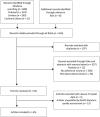Discrepancies between self-reported medication in adherence and indirect measurement adherence among patients undergoing antiretroviral therapy: a systematic review
- PMID: 38970140
- PMCID: PMC11225374
- DOI: 10.1186/s40249-024-01221-4
Discrepancies between self-reported medication in adherence and indirect measurement adherence among patients undergoing antiretroviral therapy: a systematic review
Abstract
Background: Given the critical importance of medication adherence in HIV/AIDS treatment, this study aims to compare medication adherence measured by self-report (SR) and indirect measurement among antiretroviral therapy (ART) patients, exploring the differences of adherence results measured by different tools.
Methods: We systematically searched PubMed, Embase, and the Cochrane Library to identify all relevant literature published up to November 22, 2023, without language restrictions, reporting adherence to ART measured by both SR and indirect measurement methods, while also analyzing individual and group adherence separately. Discrepancies between SR and indirect measurement results were assessed using the Mann-Whitney U test or Wilcoxon signed-rank test, with correlations evaluated using the Pearson correlation coefficient. Following one-to-one comparisons, meta-epidemiological one-step analysis was conducted, and network meta-analysis techniques were applied to compare results obtained through specific adherence assessment tools reported in the identified articles.
Results: The analysis encompassed 65 original studies involving 13,667 HIV/AIDS patients, leading to 112 one-to-one comparisons between SR and indirect measurement tools. Statistically significant differences were observed between SR and indirect measurement tools regarding both individual and group adherence (P < 0.05), with Pearson correlation coefficients of 0.843 for individual adherence and 0.684 for group adherence. During meta-epidemiological one-step analysis, SR-measured adherence was determined to be 3.94% (95% CI: -4.48-13.44%) higher for individual adherence and 16.14% (95% CI: 0.81-18.84%) higher for group adherence compared to indirectly measured results. Subgroup analysis indicated that factors such as the year of reporting and geographic region appeared to influence the discrepancies between SR and indirect measurements. Furthermore, network meta-analysis revealed that for both individual and group adherence, the results obtained from most SR and indirect measurement tools were higher than those from electronic monitoring devices, with some demonstrating statistical significance (P < 0.05).
Conclusions: The findings underscored the complexity of accurately measuring medication adherence among ART patients. Significant variability was observed across studies, with self-report methods showing a significant tendency towards overestimation. Year of reporting, geographic region, and adherence measurement tools appeared to influence the differences between SR and indirect measurements. Future research should focus on developing and validating integrated adherence measurements that can combine SR data with indirect measures to achieve a more comprehensive understanding of adherence behaviors.
Keywords: AIDS; Antiretroviral therapy; HIV; Medication adherence; Meta-epidemiological one-step analysis; Network meta-analysis; Self-report.
© 2024. The Author(s).
Conflict of interest statement
The authors declare that they have no competing interests.
Figures



Similar articles
-
Accuracy of measures for antiretroviral adherence in people living with HIV.Cochrane Database Syst Rev. 2022 Jul 25;7(7):CD013080. doi: 10.1002/14651858.CD013080.pub2. Cochrane Database Syst Rev. 2022. PMID: 35871531 Free PMC article.
-
Interventions to improve adherence to antiretroviral therapy in children with HIV infection.Cochrane Database Syst Rev. 2011 Dec 7;2011(12):CD009513. doi: 10.1002/14651858.CD009513. Cochrane Database Syst Rev. 2011. PMID: 22161452 Free PMC article.
-
Systemic treatments for metastatic cutaneous melanoma.Cochrane Database Syst Rev. 2018 Feb 6;2(2):CD011123. doi: 10.1002/14651858.CD011123.pub2. Cochrane Database Syst Rev. 2018. PMID: 29405038 Free PMC article.
-
Systemic pharmacological treatments for chronic plaque psoriasis: a network meta-analysis.Cochrane Database Syst Rev. 2017 Dec 22;12(12):CD011535. doi: 10.1002/14651858.CD011535.pub2. Cochrane Database Syst Rev. 2017. Update in: Cochrane Database Syst Rev. 2020 Jan 9;1:CD011535. doi: 10.1002/14651858.CD011535.pub3. PMID: 29271481 Free PMC article. Updated.
-
The association between disclosure and antiretroviral therapy among adults living with HIV in China: a systematic review and meta-analysis.BMC Infect Dis. 2025 Jun 2;25(1):784. doi: 10.1186/s12879-025-11009-y. BMC Infect Dis. 2025. PMID: 40457351 Free PMC article.
Cited by
-
[ART adherence and its association with depression, anxiety and stress].Rev Med Inst Mex Seguro Soc. 2025 Mar 3;63(2):e6553. doi: 10.5281/zenodo.14616894. Rev Med Inst Mex Seguro Soc. 2025. PMID: 40273326 Free PMC article. Spanish.
-
Application of causal forest double machine learning (DML) approach to assess tuberculosis preventive therapy's impact on ART adherence.Sci Rep. 2025 Aug 9;15(1):29130. doi: 10.1038/s41598-025-14460-8. Sci Rep. 2025. PMID: 40781349 Free PMC article.
References
-
- UNAIDS. UNAIDS Global AIDS Update 2023: The path that ends AIDS. 2023. Accessed 13 July 2023.
-
- Li X. Health Statistics. 8th edn: People's Medical Publishing House; 2017.
Publication types
MeSH terms
Substances
Grants and funding
- 72074161/Innovative Research Group Project of the National Natural Science Foundation of China
- 81602935/Innovative Research Group Project of the National Natural Science Foundation of China
- 2022YFS0229/Sichuan Province Science and Technology Support Program
- 2022YFS0641/Sichuan Province Science and Technology Support Program
- 23ZDYF0025/Liangshan Prefecture Science and Technology Bureau Program
LinkOut - more resources
Full Text Sources
Medical
Research Materials

